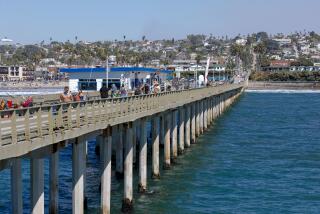Change calls at Redondo Beach’s King Harbor
A new arch has gone up across Catalina Avenue, loudly broadcasting entry to King Harbor. An abstract sculpture fountain has been built at the gateway to the Redondo Beach marina, another encouraging sign that the destination is on the rebound.
FOR THE RECORD:
King Harbor: An article in Tuesday’s Section A about revitalization of King Harbor in Redondo Beach misspelled the last name of Mayor Mike Gin as Ginn. —
The remodeled entryway is just the start of the refurbishing soon to move forward on the city’s waterfront. The owners of the hip Shade Hotel in Manhattan Beach are building a Redondo Beach branch, and the leaseholder of many of the restaurants on the pier is planning to spend as much as $2 million to refurbish the eateries. There is also a proposal for a $100-million project that will include restaurants, stores and an amphitheater.
Even a new L.A. County Harbor Patrol building is planned, replacing the temporary one that has been in use for about 20 years.
King Harbor “is one of the jewels of our city but in my mind a jewel that needs some polishing,” Mayor Mike Ginn said.
It may be symbolic, though, that water has yet to flow through the fountain because of safety problems with Southern California Edison’s high-voltage power lines overhead or that many of the new proposals to revamp King Harbor remain on the drawing board.
The harbor area took a huge hit in 1988 after a storm and fire destroyed much of the horseshoe-shaped pier.
“I don’t think we’ve completely recovered from that,” Assistant City Manager David Biggs said.
It took the city seven years and $12 million to build a smaller pier.
Today, the King Harbor area includes four privately operated marinas and 1,400 boat slips with restaurants, hotels, offices and condos.
There is also the Seaside Lagoon, a 1.5-million-gallon pool filled with ocean water that cools the turbines from a nearby power plant. The lagoon itself is struggling to meet water-quality standards and has been fined for the discharge it sends back into the harbor.
A plan to remodel it would cost $14 million, “and we don’t have that kind of money now,” Ginn said.
The biggest stumbling block to revitalizing the area is that plans to increase development by more than 40% have met determined opposition from people worried that King Harbor will lose its intimate atmosphere.
“Its primary use should be a place where people go to enjoy boating and other marine activities,” said Jim Light, president of the South Bay Parkland Conservancy. “I think it would be a travesty to turn it into a big shopping mall on the sea.”
The development dispute centers on the council’s plans to add 400,000 square feet of development, including three-story time-share condos.
The council voted to rezone the harbor in 2008 to allow the development. A few months later, voters passed Measure DD, a growth-limitation amendment to the city charter, which says major zoning changes must be put on the ballot.
Meanwhile, the California Coastal Commission turned down the zoning change and sent it back to the city with 17 minor changes. The planning commission voted late last month to accept them.
Development opponents complain that the new construction would bring gridlock and say the proposal must be put to the voters. The city has said the entire proposal does not have to be placed on the ballot.
As a result, the group of opponents known as Building a Better Redondo has hired an attorney and is raising money to sue the city if the council passes the revised plan.
“Other council members have big plans for development on our waterfront, and I don’t think the public will go for it,” said Councilman Bill Brand, who wrote DD along with Light and was elected to the council after it passed.
Light said one of the main reasons people voted for the growth limitation was that they were afraid of development in the harbor.
Brand agrees that the harbor needs to be spruced up. “Everyone wants to see some sort of revitalization,” he said.
Ginn said that a recent study showed that the area brought in $41 million annually.
“King Harbor is not only important economically, but it’s an important aesthetic and trademark asset for the city,” Ginn said. “It has been part of our city’s identity for over 50 years.”
More to Read
Sign up for Essential California
The most important California stories and recommendations in your inbox every morning.
You may occasionally receive promotional content from the Los Angeles Times.











